Did you know that there are over 3,000,000 shipwrecks scattered across the world’s ocean floors? While most remain forever out of reach, some of these fascinating underwater museums are surprisingly accessible to visitors! From snorkeling over shallow Caribbean wrecks to diving alongside massive ocean liners, these famous shipwreck locations offer once-in-a-lifetime experiences.
North America
Obviously, the most famous shipwreck in North America is RMS Titanic, but as of 2025, it’s not available to the public, especially after the Titan tragedy of June 2023. Yet, there are other shipwrecks in the region that are a lot easier to access.

1. Peter Iredale (Oregon, USA)
- Year Sunk: 1906
- Depth: Beach accessible at low tide
- Access Type: Walking/Photography
- Skill Level: All levels
- History: British sailing vessel, dramatic Pacific Northwest wreck
- Best Features: Skeletal remains visible from shore, perfect for photography
- Season: Year-round, best at low tide
2. USS Oriskany (Florida, USA)
- Year Sunk: 2006 (Intentionally scuttled)
- Depth: 45-67 meters
- Access Type: Advanced scuba diving
- Skill Level: Advanced/Technical
- History: Decommissioned aircraft carrier, world’s largest artificial reef
- Best Features: Massive flight decks and hangar bays teeming with marine life
- Season: Year-round, best April-October
3. Sweepstakes (Ontario, Canada)
- Year Sunk: 1885
- Depth: 6-20 meters
- Access Type: Snorkeling and diving
- Skill Level: Beginner to Intermediate
- History: 19th-century schooner in Georgian Bay
- Best Features: Exceptional freshwater visibility, well-preserved wooden structure
- Season: June-September optimal

4. City of Grand Rapids (Ontario, Canada)
- Year Sunk: 1907
- Depth: 6-20 meters
- Access Type: Snorkeling and diving
- Skill Level: Beginner to Intermediate
- History: Passenger and cargo steamer
- Best Features: Pristine Great Lakes preservation, clear waters
- Season: June-September optimal
Caribbean Region
The Caribbean offers some of the world’s most beginner-friendly wreck diving experiences with crystal-clear waters and year-round diving conditions.
5. Antilla Wreck (Aruba, Caribbean)
- Year Sunk: 1940
- Depth: 18-60 meters
- Access Type: Snorkeling and diving
- Skill Level: Beginner to Advanced
- History: German cargo ship scuttled during WWII
- Best Features: Largest shipwreck in the Caribbean, crystal-clear waters
- Season: Year-round, avoid hurricane season
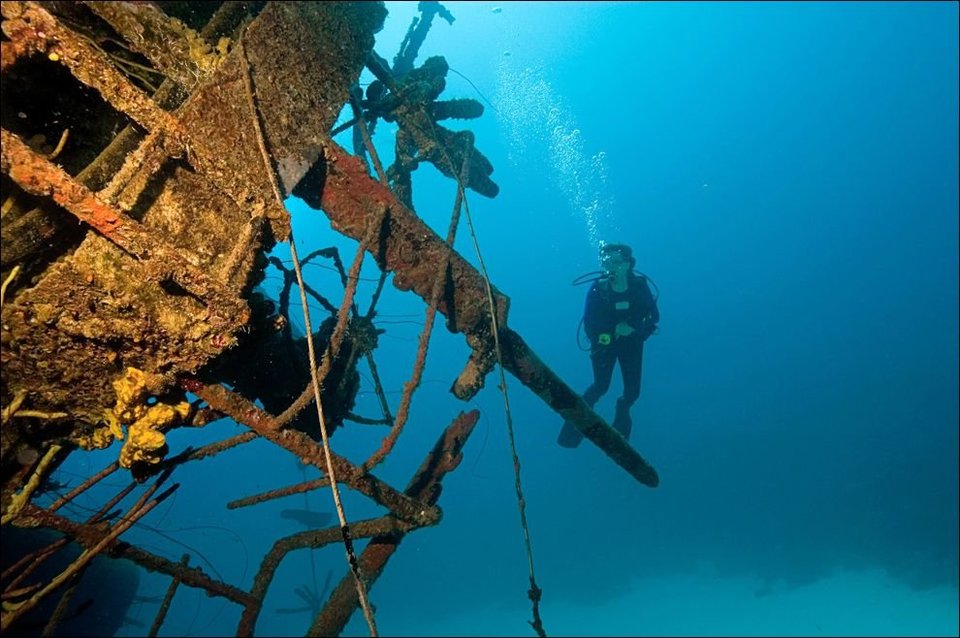
6. Hilma Hooker (Bonaire, Caribbean)
- Year Sunk: 1984
- Depth: 18-42 meters
- Access Type: Scuba diving
- Skill Level: Beginner to Intermediate
- History: Cargo ship with mysterious sinking circumstances
- Best Features: Intact structure, exceptional marine life photography
- Season: Year-round, best visibility December-April
7. Wreck of the Rhone (British Virgin Islands)
- Year Sunk: 1867
- Depth: 6-24 meters
- Access Type: Snorkeling and diving
- Skill Level: All levels
- History: Royal Mail Steamer destroyed by hurricane
- Best Features: Featured in “The Deep,” multiple depth options
- Season: November-April optimal
Red Sea Corridor
The Red Sea’s exceptional visibility and preservation conditions make it a shipwreck diving paradise, and the best destination to get a diving intro.
8. SS Thistlegorm (Red Sea, Egypt)
- Year Sunk: 1941
- Depth: 16-32 meters
- Access Type: Scuba diving
- Skill Level: Intermediate to Advanced
- History: British merchant vessel carrying WWII supplies
- Best Features: Well-preserved cargo, including motorcycles, trucks, and aircraft parts
- Season: October-April for best conditions
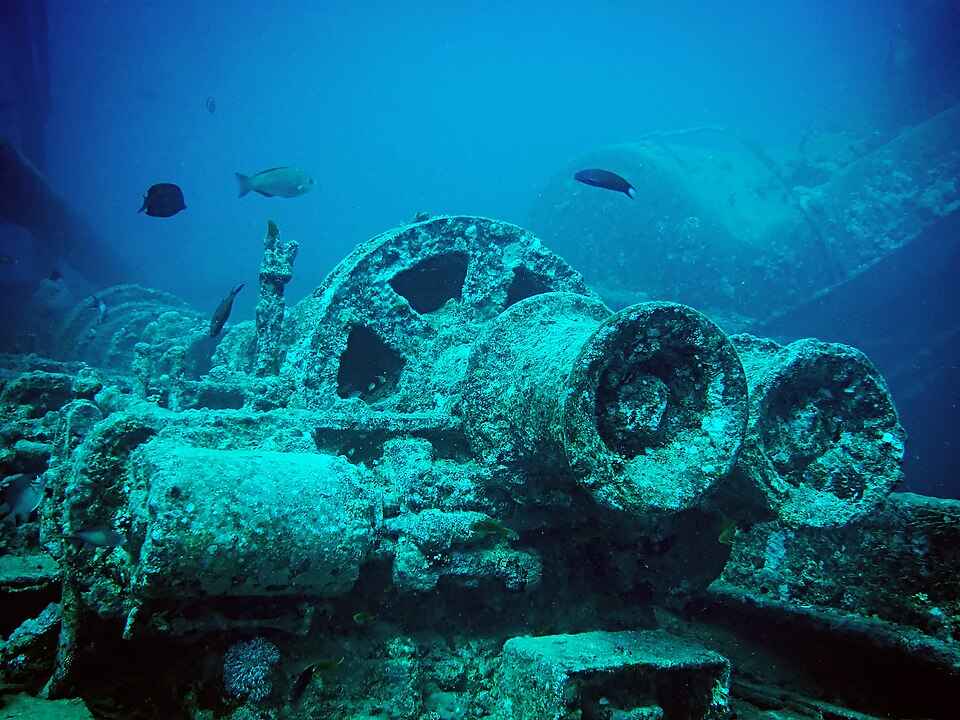
9. MV Salem (Red Sea, Egypt)
- Year Sunk: 1993
- Depth: 12-35 meters
- Access Type: Scuba diving
- Skill Level: Beginner to Intermediate
- History: Modern cargo ship wreck
- Best Features: Intact structure, minimal marine growth, ideal for photography
- Season: October-April optimal
10. Giannis D. (Red Sea, Egypt)
- Year Sunk: 1983
- Depth: 5-27 meters
- Access Type: Scuba diving
- Skill Level: Intermediate to Advanced
- History: Cargo ship broken in half
- Best Features: Multiple penetration opportunities, cargo holds full of marine life
- Season: Year-round, best October-April
Mediterranean
10. MS Zenobia (Cyprus, Mediterranean)
- Year Sunk: 1980
- Depth: 16-42 meters
- Access Type: Scuba diving
- Skill Level: Beginner to Advanced
- History: Modern ferry with trucks still on vehicle decks
- Best Features: Consistently ranked the world’s top 10 wreck dive, intact structure
- Season: May-October is optimal; year-round diving is possible
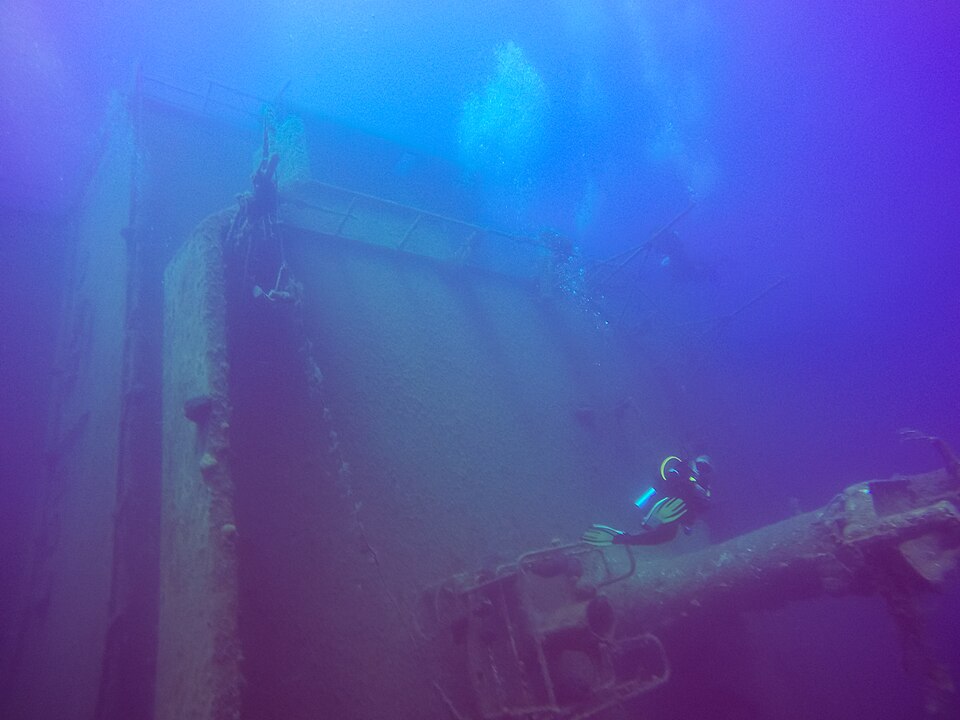
Pacific
11. USAT Liberty (Bali, Indonesia)
- Year Sunk: 1942 (Beached), 1963 (Mount Agung eruption moved to current position)
- Depth: 5-30 meters
- Access Type: Snorkeling and diving
- Skill Level: All levels
- History: WWII cargo ship, now an artificial reef
- Best Features: Over 400 fish species, vibrant coral growth, and shore access
- Season: April-October, dry season optimal
12. Fujikawa Maru (Truk Lagoon, Micronesia)
- Year Sunk: 1944
- Depth: 10-34 meters
- Access Type: Scuba diving
- Skill Level: Intermediate
- History: WWII Japanese cargo vessel, Operation Hailstone victim
- Best Features: Perfectly preserved aircraft and equipment, an underwater museum
- Season: Year-round, best December-April
13. Star of Greece (Port Willunga, South Australia)
- Year Sunk: 1888
- Depth: 2–6 meters
- Access Type: Snorkeling and shore diving
- Skill Level: Beginner
- History: British clipper wrecked in heavy seas while anchored offshore to load cargo
- Best Features: Clearly visible iron hull and timbers, accessible directly from the beach
- Season: Best in summer months (December–March) when visibility is highest
14. USS Saratoga (CV‑3), Bikini Atoll, Marshall Islands
- Year Sunk: 1946
- Depth: Sits upright at 51 meters; flight deck at ~27 meters, superstructure reaches up to ~18 meters
- Access Type: Technical scuba diving (closed-circuit rebreather recommended)
- Skill Level: Advanced – suitable for experienced divers with wreck and deep dive training
- History: Early U.S. Navy aircraft carrier, launched in the 1920s and used in WWII. Sunk during Operation Crossroads nuclear testing in 1946
- Best Features: Intact flight deck, open bridge, medical rooms, and deep interior spaces; popular for extended penetration dives
- Season: May to October – dry season with calm, clear lagoon conditions
Northern Waters
The northern waters have a lot less diverse marine life; due to this fact, they are the best to preserve the shipwreck sites within them
15. Scapa Flow Wrecks (Scotland)
- Year Sunk: 1919
- Depth: 12-45 meters
- Access Type: Advanced scuba diving
- Skill Level: Advanced/Technical
- History: German High Seas Fleet mass scuttling after WWI
- Best Features: World’s greatest collection of WWI naval wrecks
- Season: May-September optimal
Snorkeling vs. Diving Sites
Some of the famous shipwrecks are visible from the shore or water, especially during low tide. Many sites, Egyptian ones in particular, are a great start for the new Open Water certificate holders. While some items on the list present a challenge even for experienced divers due to the cold water or strong currents.
Shallow water sites (0 – 10 meters)
- Peter Iredale (Oregon) – Beach accessible
- Star of Greece (Australia) – Visible at low tide
- Antilla Wreck (Aruba) – Snorkeling sections available
- Sweepstakes (Ontario) – Crystal clear freshwater
Beginner dive sites
| Site | Depth Range | Water Temp | Visibility | Current |
|---|---|---|---|---|
| USAT Liberty | 5-30m | 26-29°C | 15-30m | Minimal |
| Hilma Hooker | 18-42m | 26-28°C | 30m+ | Light |
| Wreck of Rhone | 6-24m | 24-29°C | 20-40m | Moderate |
Advanced diving destinations
- USS Oriskany: Deep penetration, strong currents
- Giannis D.: Complex structure, multiple entry points
- Scapa Flow Wrecks: Cold water, limited visibility
Historical Context
The Golden Age of Steamships (1840-1920)
The period between 1840 and 1920 marked the golden age of steamship travel, when massive vessels crossed oceans carrying passengers, cargo, and dreams of new lives. Many of today’s most famous shipwreck sites originated from this era.
“Every shipwreck is a time capsule, preserving a moment in maritime history that would otherwise be lost to time.” – Dr. Robert Ballard, Ocean Explorer
Timeline of Famous Maritime Disasters
- 1867: RMS Rhone destroyed by hurricane in the Caribbean
- 1888: Star of Greece wrecked off the South Australian coast
- 1906: Peter Iredale ran aground on an Oregon beach
- 1912: RMS Titanic strikes iceberg, becomes world’s most famous wreck
- 1919: German High Seas Fleet scuttled at Scapa Flow
World War II Naval Heritage
WWII created numerous military shipwreck locations that now serve as underwater memorials:
Operation Hailstone Legacy
In February 1944, the US Navy’s “Operation Hailstone” transformed Truk Lagoon into the world’s largest underwater museum, with over 60 vessels and 400 aircraft resting on the seafloor.
Atlantic and Mediterranean Theaters
- SS Thistlegorm: Victim of a German air attack while carrying supplies to North Africa
- USAT Liberty: Torpedoed off Bali, later moved to shallow water as an artificial reef
- Antilla: Self-scuttled by German crew to prevent Allied capture
Safety and Ecology
Shipwreck diving involves structurally unstable environments, entanglement risks, and ecologically sensitive zones. Divers can unintentionally damage habitats or compromise their own safety without clear guidelines.
The WRECK Protocol is a standardized field safety checklist used by dive instructors, conservation teams, and wreck tourism operators to prevent injuries and ensure minimal ecological disturbance. It applies to both recreational and technical dives and is especially relevant in high-traffic artificial reef sites where diver behavior directly affects long-term ecosystem health
The WRECK Protocol
- Watch for sharp edges and unstable structures
- Respect the site – no artifact removal
- Emergency planning – always dive with backup plans
- Conservation awareness – minimize environmental impact
- Know your limits – never exceed certification level
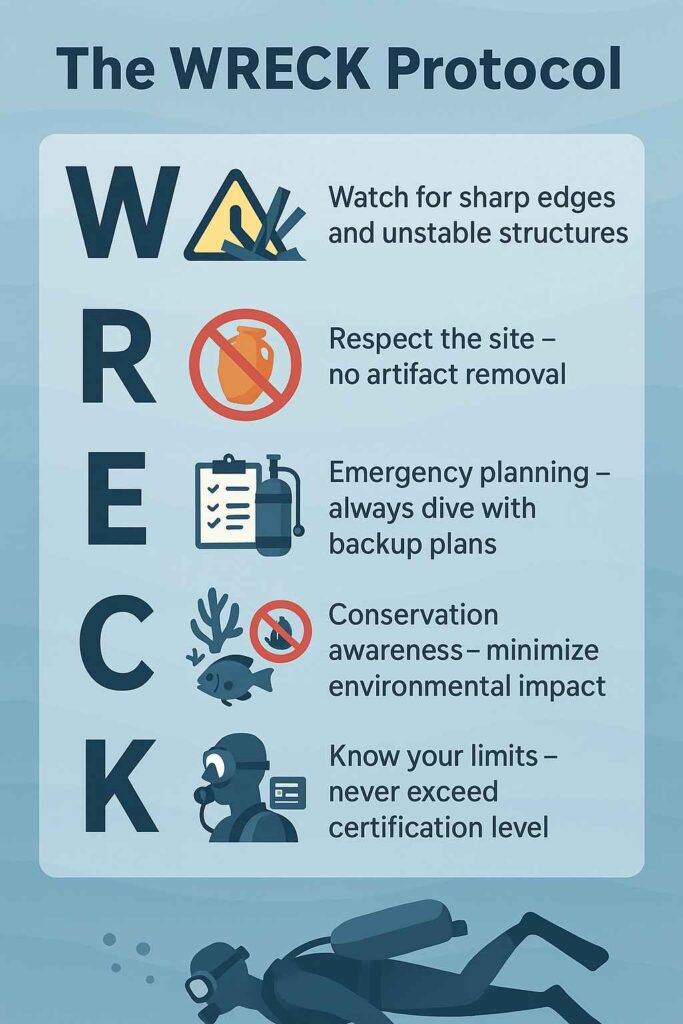
Artificial Reef Ecosystems
Luckily, a ship’s history often doesn’t end with sinking, so it starts a second life underwater. Metal surfaces turn into landing spots for algae and tiny animals, which quickly attract fish looking for food and shelter. Over months and years, more species move in, from corals and sponges to larger predators. What began as a wreck slowly becomes a busy marine neighborhood, often matching natural reefs in both activity and biodiversity.
Succession Stages
- Immediate Colonization (0-6 months)
- Bacteria and algae establish base ecosystem
- Small invertebrates begin settlement
- Primary Growth (6 months – 2 years)
- Coral polyps and sponges attach to surfaces
- Small fish species establish territories
- Mature Ecosystem (2+ years)
- Complex food webs develop
- Large predatory species frequent the site
- Biodiversity peaks with hundreds of species
- Complex food webs develop
The USS Oriskany, USAT Liberty, and MS Zenobia show what happens when a wreck is left in place and given time. Each one started as a bare structure and gradually turned into a thriving reef. Today, they’re home to everything from small reef fish to large predators, and they’ve become key parts of their local ecosystems.
- USS Oriskany: Now supports over 200 fish species
- USAT Liberty: Hosts giant bumphead parrotfish and schools of barracuda
- MS Zenobia: Grouper population recovery documented over 40 years

Planning Your Shipwreck Adventure
By now, it’s clear that some of the shipwrecks demand careful navigation and reward those who approach them with respect and preparation. Not all wrecks are accessible year-round, and conditions like visibility, currents, and water temperature can vary widely by season. Some locations are known for specific wildlife encounters, while others require advanced certifications or specialized gear.
Diving Seasons and Conditions
| Region | Best Months | Water Temp | Visibility | Special Considerations |
|---|---|---|---|---|
| Caribbean | Nov-Apr | 24-29°C | 20-40m | Hurricane season May-Oct |
| Red Sea | Oct-Apr | 20-26°C | 30-50m | Avoid summer heat |
| Mediterranean | May-Oct | 16-25°C | 15-30m | Winter storms common |
| Pacific (Tropical) | Apr-Oct | 26-30°C | 15-35m | Monsoon variations |
| North Atlantic | Jun-Sep | 8-18°C | 10-25m | Rough seas in winter |
Seasonal Wildlife Encounters
Unfortunately, the best times for wildlife encounters aren’t the same as the best diving experience for shipwreck exploration. Here’s an approximate breakdown of wildlife activity by region to consider during planning:
- Manta Ray Season (Red Sea): May-September
- Whale Shark Encounters (Caribbean): June-September
- Seal Populations (Scapa Flow): Year-round, most active summer
- Tropical Fish Spawning (Indo-Pacific): March-May
Equipment Essentials
The right gear can make or break a shipwreck experience. For divers, that starts with a well-fitted mask and a reliable regulator—two things you don’t want to second-guess once you’re underwater. A dive computer is just as important, especially around wrecks where depth and bottom time can vary quickly. If the site allows for penetration, a dive light is a must, even during the day. Many wreck interiors are dark, and a good torch helps you spot hazards and marine life without stirring up sediment.
For Snorkeling:
- High-quality mask with a good seal
- Snorkel with a dry-top feature
- Fins appropriate for conditions
- Rashguard or wetsuit for protection
- Underwater camera for documentation
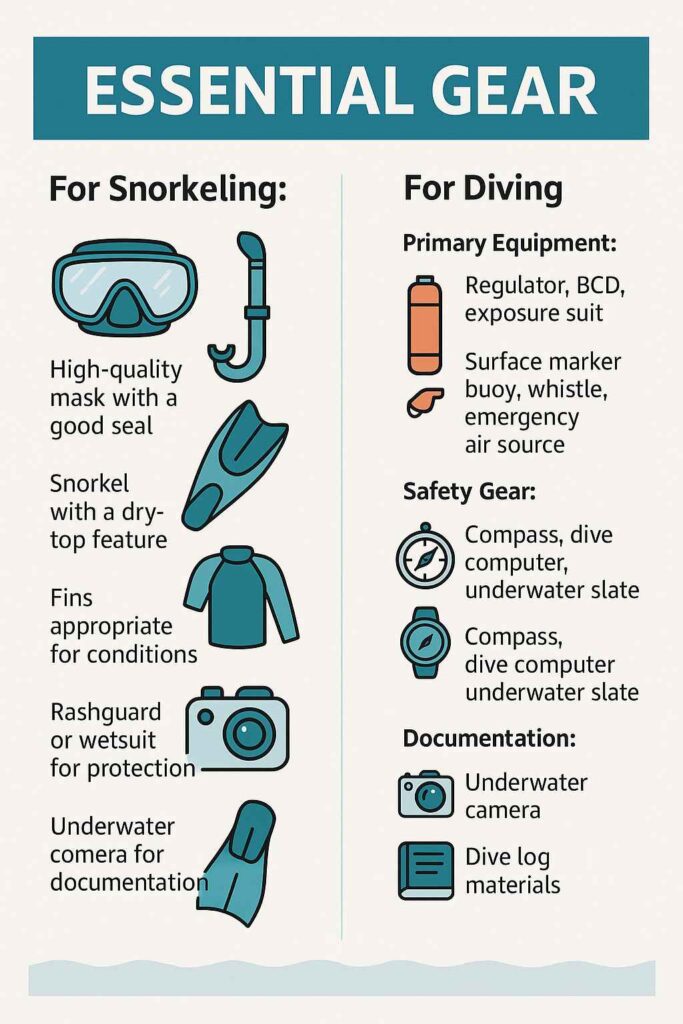
For Diving:
- Primary Equipment: Regulator, BCD, exposure suit
- Safety Gear: Surface marker buoy, whistle, emergency air source
- Navigation: Compass, dive computer, underwater slate
- Documentation: Underwater camera, dive log materials
For snorkeling around shallow wrecks, the setup is simpler but still worth doing right. A dry-top snorkel helps avoid mouthfuls of seawater in choppy conditions, and fins should match the type of swimming you’ll do: short fins for tight areas, longer ones for covering distance. Rash guards or thin wetsuits add warmth and protection against scrapes or jellyfish.
In both cases, gloves may be discouraged or even banned to prevent damage to coral-covered surfaces, so check local guidelines before packing them. Always bring a surface marker buoy, especially in areas with boat traffic. Even on calm days, visibility from the surface can drop fast near wrecks, and that little orange tube could save your life.
Certification and Training Requirements
Of course, the required preparation depends on specific plans for the shipwreck and the duration of the underwater stay. For example, partial exploration of SS Thistlegorm can be done with the basic Open Water certificate, but the full site exploration will require an advanced certification.
Entry Level: Open Water
The most suitable wrecks for open water certificate holders are the shallow sections of USAT Liberty, and the upper structure of the Antilla wreck. Bonaire is just a short hop away.
- USAT Liberty (Bali) – Shallow sections
- Antilla Wreck (Aruba) – Upper structure
- Wreck of Rhone (BVI) – Bow section
Intermediate Level: Advanced Open Water
As mentioned before, full exploration of a shipwreck in most cases requires an Advanced Open Water certification:
- SS Thistlegorm (Egypt) – Full exploration
- MS Zenobia (Cyprus) – Exterior diving
- Hilma Hooker (Bonaire) – Complete wreck
Expert Level: Technical Diving
Deep wrecks and extended bottom stays will most likely need a more technical certificate and the usage of breathing mixes like nitrox or trimix:
- Trimix Certification: For deep wrecks like USS Oriskany
- Wreck Penetration: For interior exploration
- Decompression Procedures: For extended bottom times
Budget Considerations (USD)
These budget assessments are very approximate: the training costs will vary depending on the location, the gear can prices depend on the manufacturer, while the biggest recurring expense for advanced diving are the costs of breating mixes.
| Experience Level | Daily Cost Range | Equipment | Training |
|---|---|---|---|
| Snorkeling | $50-150 | $100-300 | Minimal |
| Recreational Diving | $100-300 | $1,000-3,000 | $300-500 |
| Technical Diving | $200-500 | $3,000-8,000 | $1,000-2,500 |
Sample Itineraries
Planning a wreck dive trip often comes down to matching your interests, skill level, and available time with the right regions and sites. These sample itineraries provide a starting point; each one is designed to strike a balance between dive intensity, site variety, and local logistics.
Caribbean Island Hopping (10 days)
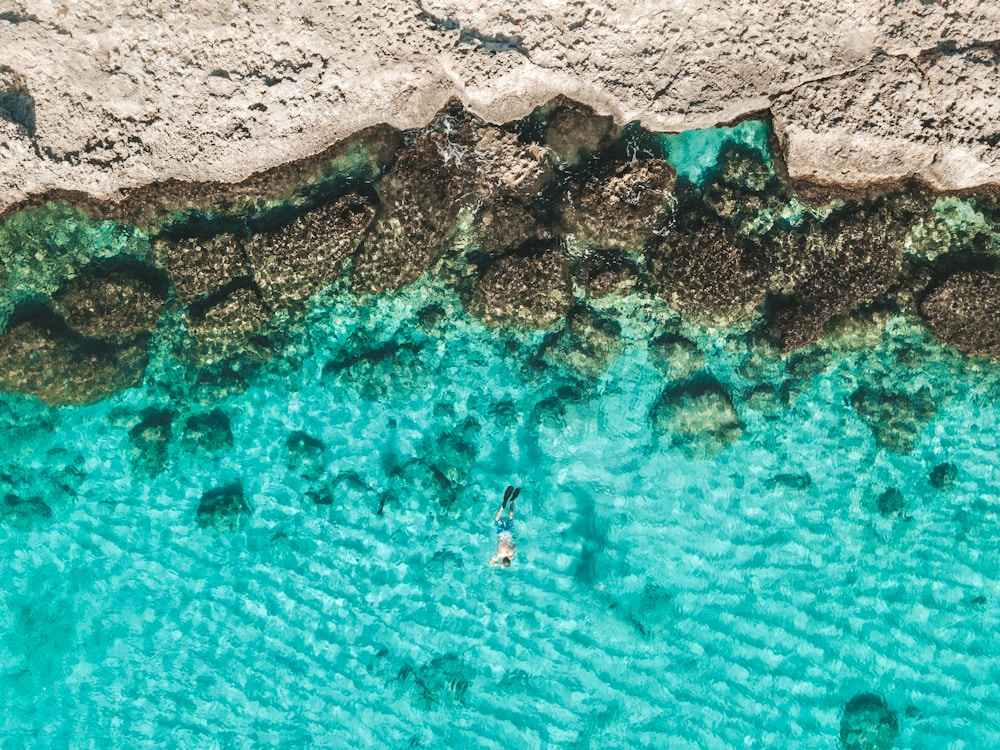
This route is ideal for recreational divers looking for a mix of easy wrecks, clear water, and laid-back island travel. Short travel distances and consistent weather make this a reliable warm-water itinerary.
- Days 1-3: Aruba – Antilla Wreck exploration
- Days 4-6: Bonaire – Hilma Hooker and reef diving
- Days 7-10: British Virgin Islands – Wreck of Rhone
Red Sea Expedition (7 days)
The Red Sea delivers warm temperatures, excellent visibility, and a mix of historic and artificial wrecks. Starting in Hurghada, divers can explore the MV Salem Express and nearby reef systems. Moving south to Dahab, liveaboard trips offer access to the SS Thistlegorm, one of the most photographed WWII wrecks in the world.
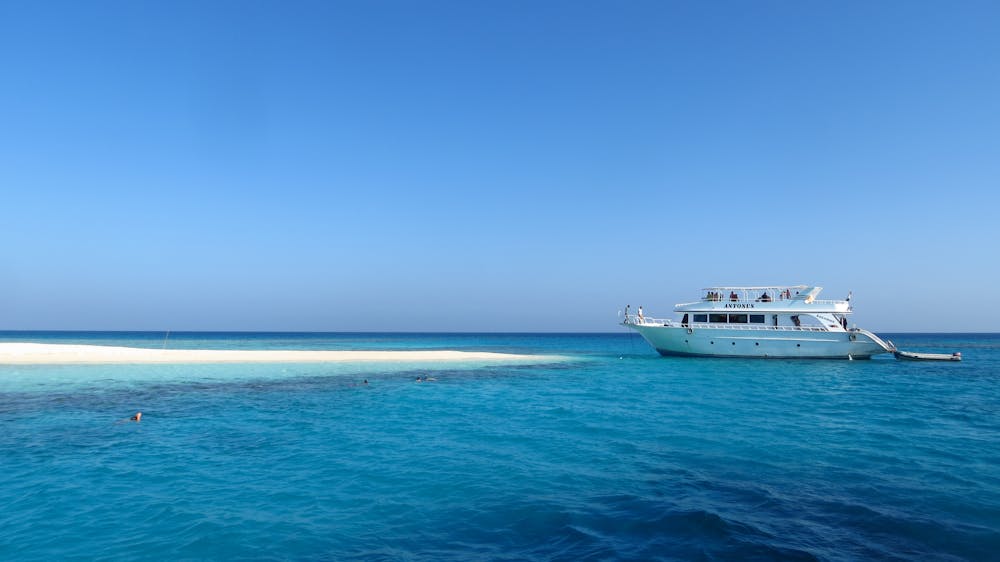
The trip ends in Sharm el-Sheikh, home to a cluster of wreck sites and strong infrastructure for multi-dive days. This itinerary works well for intermediate to advanced divers who want maximum dive time in a compact schedule.
- Days 1-2: Hurghada – MV Salem and local reefs
- Days 3-5: Dahab – SS Thistlegorm liveaboard
- Days 6-7: Sharm el-Sheikh – Multiple wreck sites
Technical Diving Challenge (14 days)
This 2-week itinerary is aimed at experienced divers with technical certifications. The first week is based in Cyprus, focusing on the MS Zenobia. With multiple descent points and depths beyond 40 meters, it provides a full range of decompression and trimix opportunities.
The second week is at Scapa Flow in Scotland. The remains of the German High Seas Fleet lie in depths accessible only to well-prepared divers. This route combines historical depth with technical complexity and cold-water exposure.
- Week 1: Cyprus – MS Zenobia intensive
- Week 2: Scotland – Scapa Flow expedition

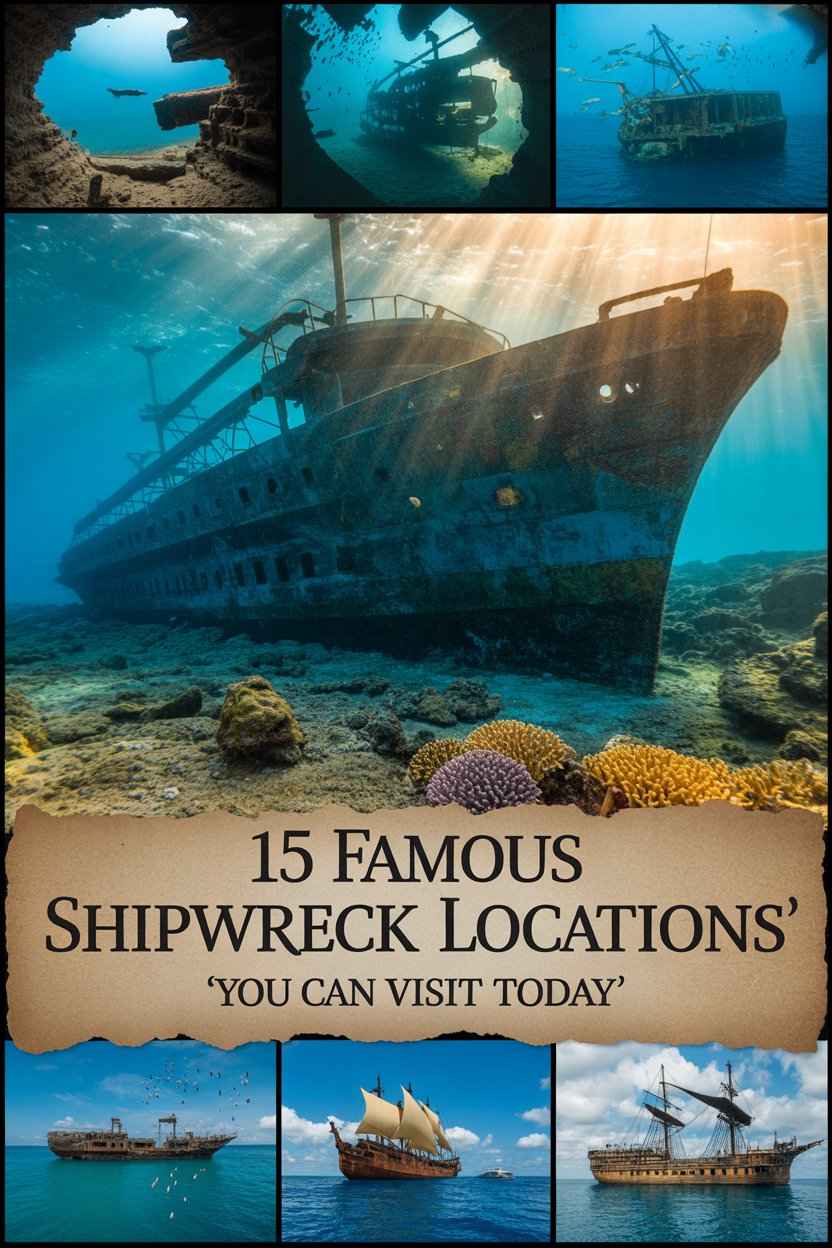
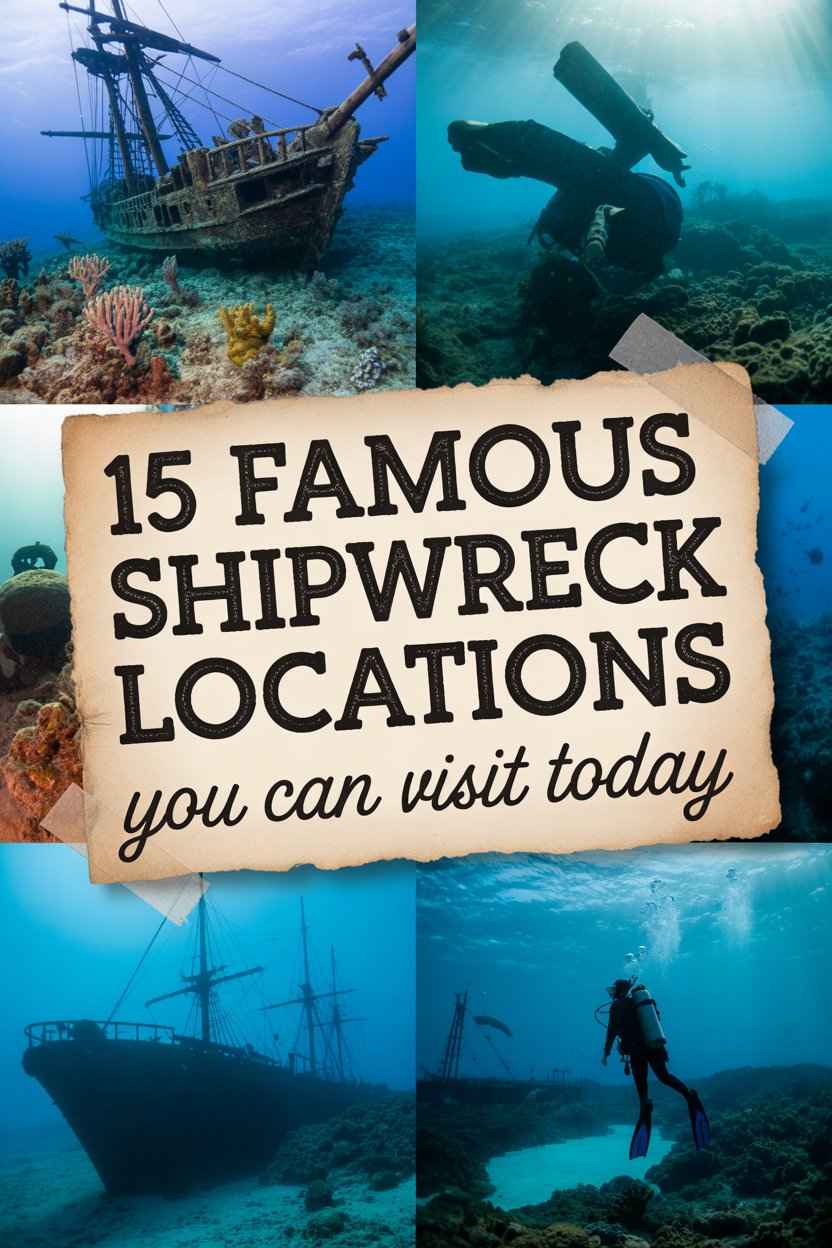
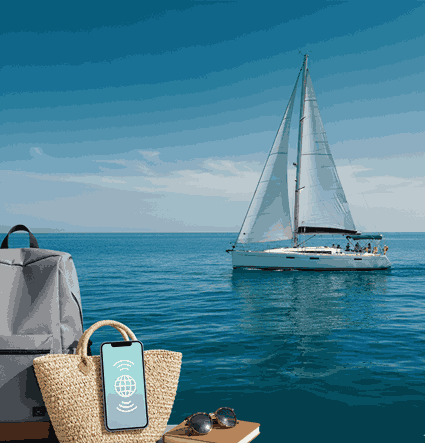



Comments